Developments in Nursing Care
VerifiedAdded on 2023/06/05
|17
|4170
|327
AI Summary
This report discusses the impact of compassion fatigue on critical care nurses and how it affects their productivity. It also provides an overview of changes that have influenced critical care nursing, evidence of analysis of observation in critical care area, and current compassionate culture. The report recommends an appropriate project to improve compassion satisfaction and human flourishing.
Contribute Materials
Your contribution can guide someone’s learning journey. Share your
documents today.
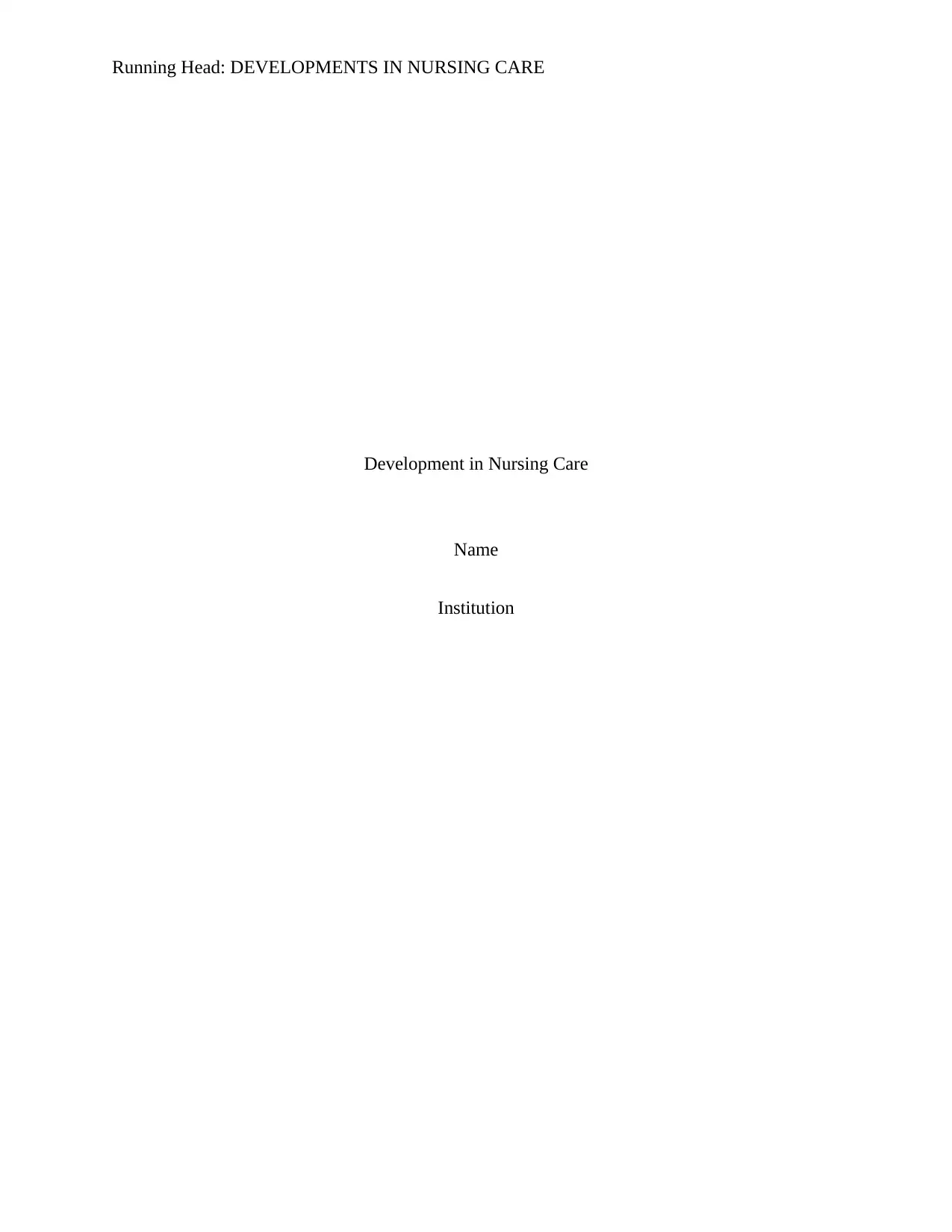
Running Head: DEVELOPMENTS IN NURSING CARE
Development in Nursing Care
Name
Institution
Development in Nursing Care
Name
Institution
Secure Best Marks with AI Grader
Need help grading? Try our AI Grader for instant feedback on your assignments.
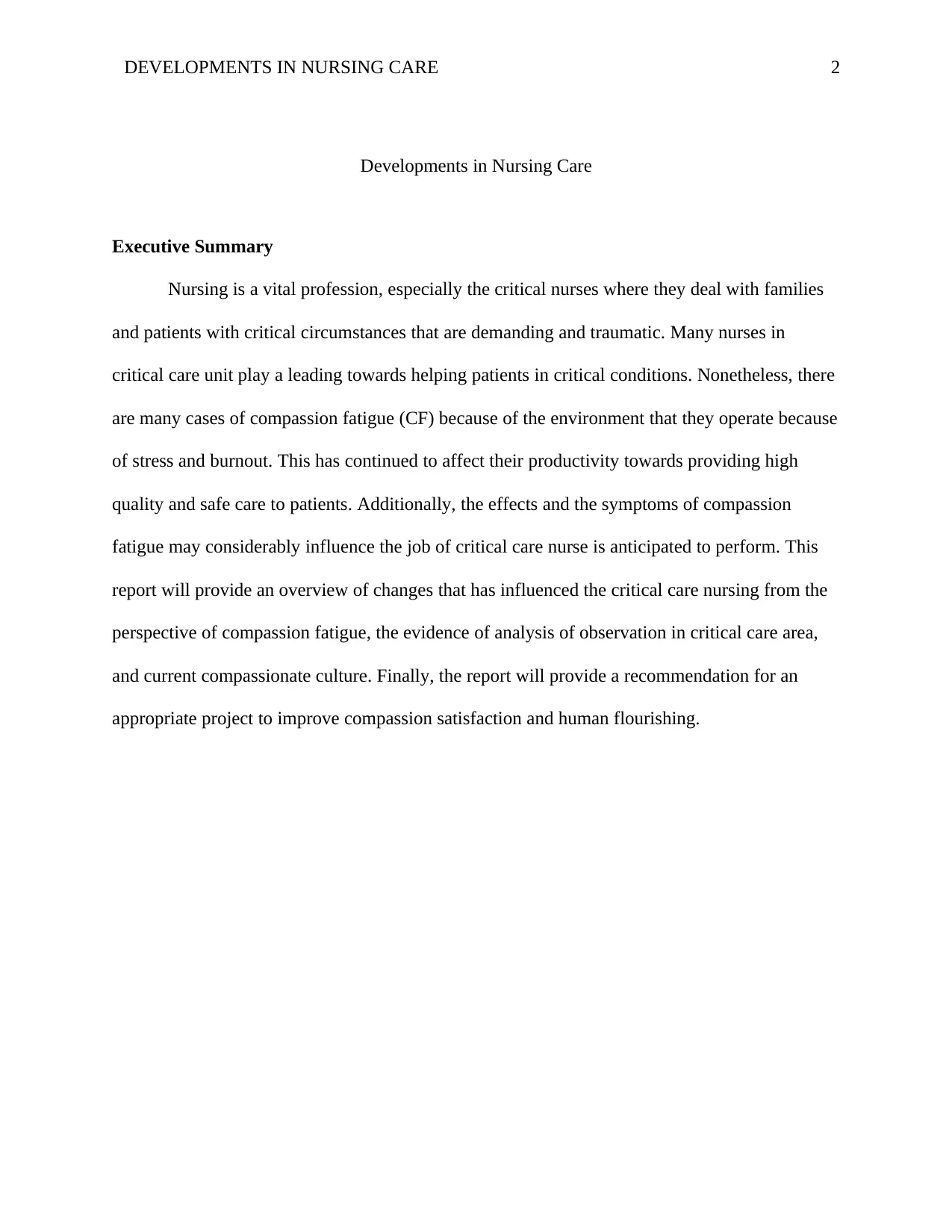
DEVELOPMENTS IN NURSING CARE 2
Developments in Nursing Care
Executive Summary
Nursing is a vital profession, especially the critical nurses where they deal with families
and patients with critical circumstances that are demanding and traumatic. Many nurses in
critical care unit play a leading towards helping patients in critical conditions. Nonetheless, there
are many cases of compassion fatigue (CF) because of the environment that they operate because
of stress and burnout. This has continued to affect their productivity towards providing high
quality and safe care to patients. Additionally, the effects and the symptoms of compassion
fatigue may considerably influence the job of critical care nurse is anticipated to perform. This
report will provide an overview of changes that has influenced the critical care nursing from the
perspective of compassion fatigue, the evidence of analysis of observation in critical care area,
and current compassionate culture. Finally, the report will provide a recommendation for an
appropriate project to improve compassion satisfaction and human flourishing.
Developments in Nursing Care
Executive Summary
Nursing is a vital profession, especially the critical nurses where they deal with families
and patients with critical circumstances that are demanding and traumatic. Many nurses in
critical care unit play a leading towards helping patients in critical conditions. Nonetheless, there
are many cases of compassion fatigue (CF) because of the environment that they operate because
of stress and burnout. This has continued to affect their productivity towards providing high
quality and safe care to patients. Additionally, the effects and the symptoms of compassion
fatigue may considerably influence the job of critical care nurse is anticipated to perform. This
report will provide an overview of changes that has influenced the critical care nursing from the
perspective of compassion fatigue, the evidence of analysis of observation in critical care area,
and current compassionate culture. Finally, the report will provide a recommendation for an
appropriate project to improve compassion satisfaction and human flourishing.
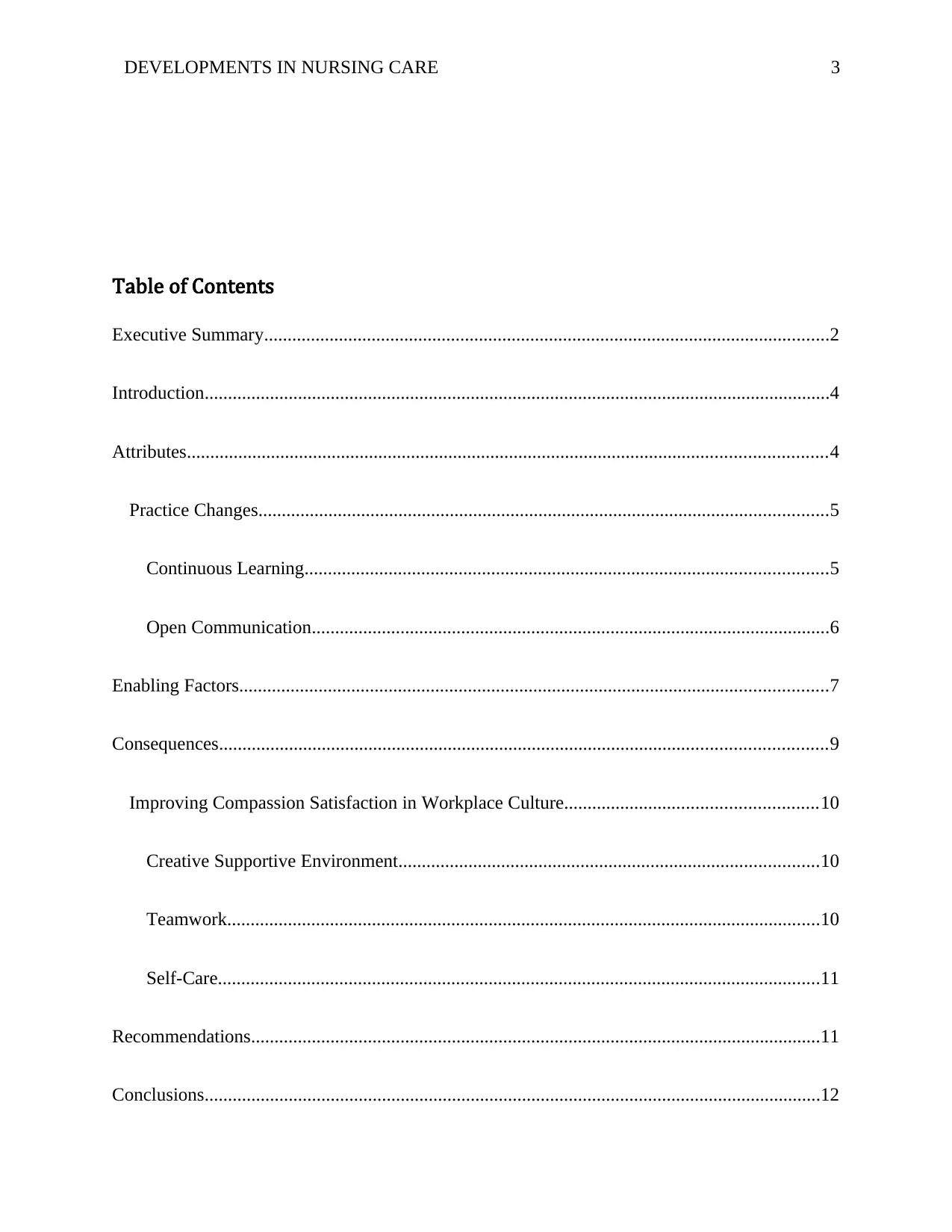
DEVELOPMENTS IN NURSING CARE 3
Table of Contents
Executive Summary.........................................................................................................................2
Introduction......................................................................................................................................4
Attributes.........................................................................................................................................4
Practice Changes..........................................................................................................................5
Continuous Learning................................................................................................................5
Open Communication...............................................................................................................6
Enabling Factors..............................................................................................................................7
Consequences..................................................................................................................................9
Improving Compassion Satisfaction in Workplace Culture......................................................10
Creative Supportive Environment..........................................................................................10
Teamwork...............................................................................................................................10
Self-Care.................................................................................................................................11
Recommendations..........................................................................................................................11
Conclusions....................................................................................................................................12
Table of Contents
Executive Summary.........................................................................................................................2
Introduction......................................................................................................................................4
Attributes.........................................................................................................................................4
Practice Changes..........................................................................................................................5
Continuous Learning................................................................................................................5
Open Communication...............................................................................................................6
Enabling Factors..............................................................................................................................7
Consequences..................................................................................................................................9
Improving Compassion Satisfaction in Workplace Culture......................................................10
Creative Supportive Environment..........................................................................................10
Teamwork...............................................................................................................................10
Self-Care.................................................................................................................................11
Recommendations..........................................................................................................................11
Conclusions....................................................................................................................................12
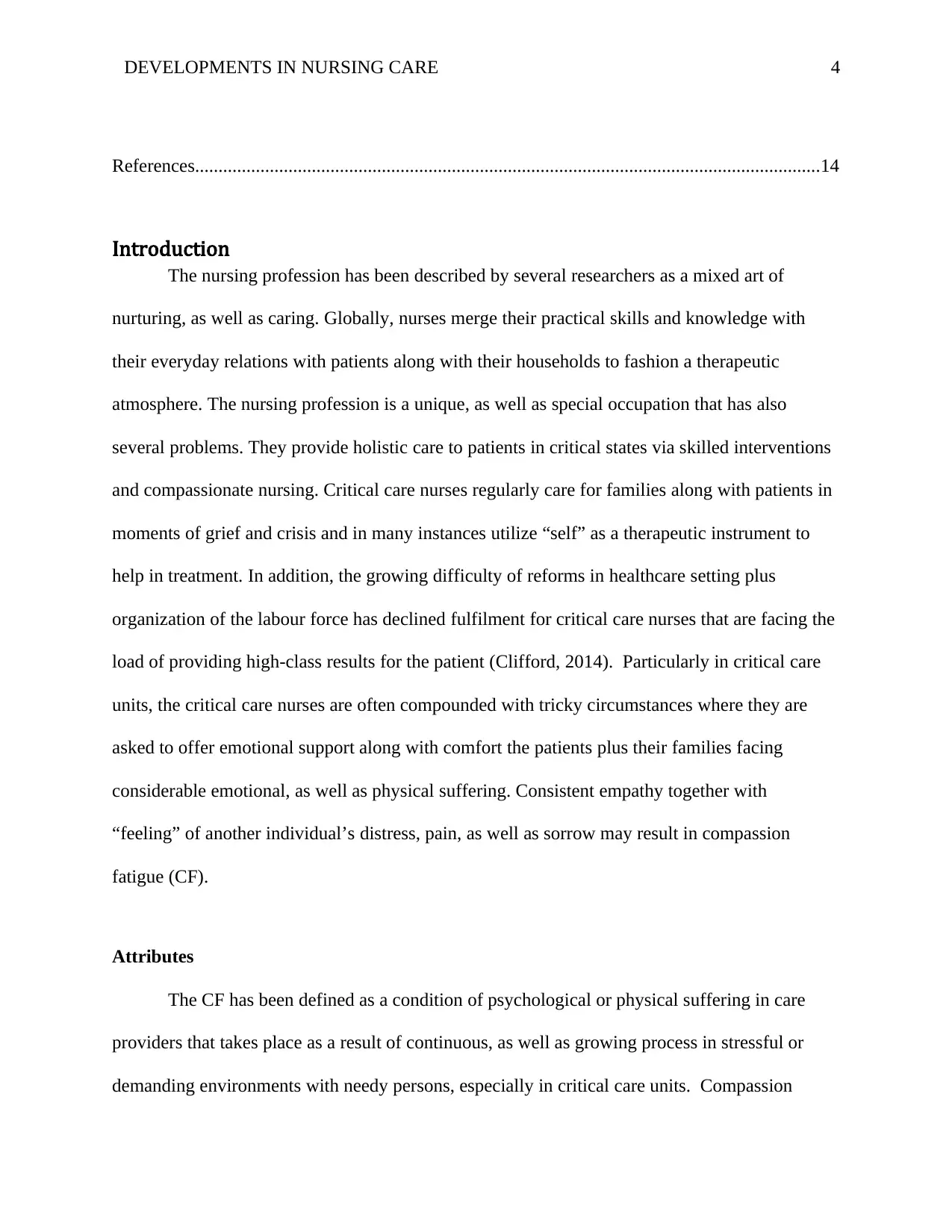
DEVELOPMENTS IN NURSING CARE 4
References......................................................................................................................................14
Introduction
The nursing profession has been described by several researchers as a mixed art of
nurturing, as well as caring. Globally, nurses merge their practical skills and knowledge with
their everyday relations with patients along with their households to fashion a therapeutic
atmosphere. The nursing profession is a unique, as well as special occupation that has also
several problems. They provide holistic care to patients in critical states via skilled interventions
and compassionate nursing. Critical care nurses regularly care for families along with patients in
moments of grief and crisis and in many instances utilize “self” as a therapeutic instrument to
help in treatment. In addition, the growing difficulty of reforms in healthcare setting plus
organization of the labour force has declined fulfilment for critical care nurses that are facing the
load of providing high-class results for the patient (Clifford, 2014). Particularly in critical care
units, the critical care nurses are often compounded with tricky circumstances where they are
asked to offer emotional support along with comfort the patients plus their families facing
considerable emotional, as well as physical suffering. Consistent empathy together with
“feeling” of another individual’s distress, pain, as well as sorrow may result in compassion
fatigue (CF).
Attributes
The CF has been defined as a condition of psychological or physical suffering in care
providers that takes place as a result of continuous, as well as growing process in stressful or
demanding environments with needy persons, especially in critical care units. Compassion
References......................................................................................................................................14
Introduction
The nursing profession has been described by several researchers as a mixed art of
nurturing, as well as caring. Globally, nurses merge their practical skills and knowledge with
their everyday relations with patients along with their households to fashion a therapeutic
atmosphere. The nursing profession is a unique, as well as special occupation that has also
several problems. They provide holistic care to patients in critical states via skilled interventions
and compassionate nursing. Critical care nurses regularly care for families along with patients in
moments of grief and crisis and in many instances utilize “self” as a therapeutic instrument to
help in treatment. In addition, the growing difficulty of reforms in healthcare setting plus
organization of the labour force has declined fulfilment for critical care nurses that are facing the
load of providing high-class results for the patient (Clifford, 2014). Particularly in critical care
units, the critical care nurses are often compounded with tricky circumstances where they are
asked to offer emotional support along with comfort the patients plus their families facing
considerable emotional, as well as physical suffering. Consistent empathy together with
“feeling” of another individual’s distress, pain, as well as sorrow may result in compassion
fatigue (CF).
Attributes
The CF has been defined as a condition of psychological or physical suffering in care
providers that takes place as a result of continuous, as well as growing process in stressful or
demanding environments with needy persons, especially in critical care units. Compassion
Secure Best Marks with AI Grader
Need help grading? Try our AI Grader for instant feedback on your assignments.
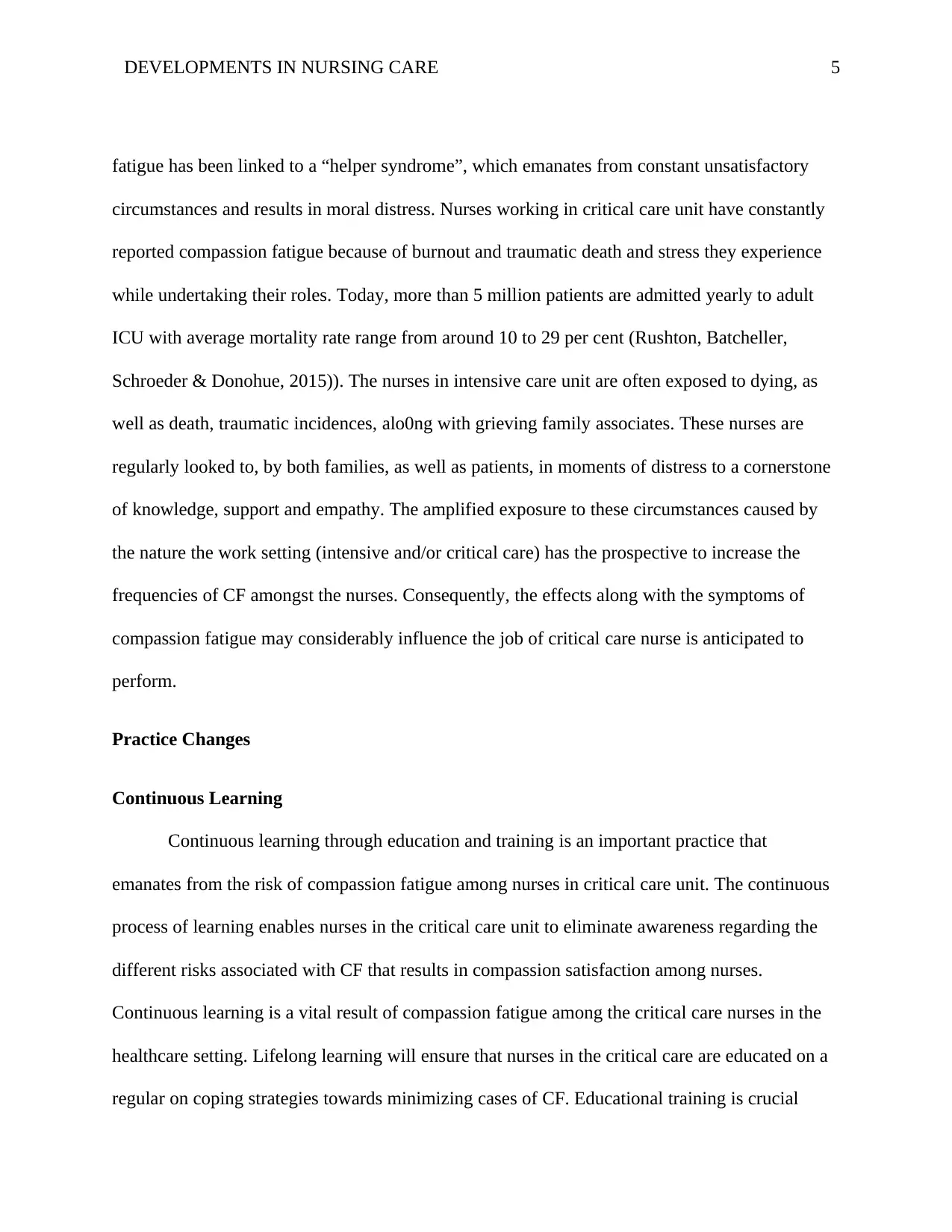
DEVELOPMENTS IN NURSING CARE 5
fatigue has been linked to a “helper syndrome”, which emanates from constant unsatisfactory
circumstances and results in moral distress. Nurses working in critical care unit have constantly
reported compassion fatigue because of burnout and traumatic death and stress they experience
while undertaking their roles. Today, more than 5 million patients are admitted yearly to adult
ICU with average mortality rate range from around 10 to 29 per cent (Rushton, Batcheller,
Schroeder & Donohue, 2015)). The nurses in intensive care unit are often exposed to dying, as
well as death, traumatic incidences, alo0ng with grieving family associates. These nurses are
regularly looked to, by both families, as well as patients, in moments of distress to a cornerstone
of knowledge, support and empathy. The amplified exposure to these circumstances caused by
the nature the work setting (intensive and/or critical care) has the prospective to increase the
frequencies of CF amongst the nurses. Consequently, the effects along with the symptoms of
compassion fatigue may considerably influence the job of critical care nurse is anticipated to
perform.
Practice Changes
Continuous Learning
Continuous learning through education and training is an important practice that
emanates from the risk of compassion fatigue among nurses in critical care unit. The continuous
process of learning enables nurses in the critical care unit to eliminate awareness regarding the
different risks associated with CF that results in compassion satisfaction among nurses.
Continuous learning is a vital result of compassion fatigue among the critical care nurses in the
healthcare setting. Lifelong learning will ensure that nurses in the critical care are educated on a
regular on coping strategies towards minimizing cases of CF. Educational training is crucial
fatigue has been linked to a “helper syndrome”, which emanates from constant unsatisfactory
circumstances and results in moral distress. Nurses working in critical care unit have constantly
reported compassion fatigue because of burnout and traumatic death and stress they experience
while undertaking their roles. Today, more than 5 million patients are admitted yearly to adult
ICU with average mortality rate range from around 10 to 29 per cent (Rushton, Batcheller,
Schroeder & Donohue, 2015)). The nurses in intensive care unit are often exposed to dying, as
well as death, traumatic incidences, alo0ng with grieving family associates. These nurses are
regularly looked to, by both families, as well as patients, in moments of distress to a cornerstone
of knowledge, support and empathy. The amplified exposure to these circumstances caused by
the nature the work setting (intensive and/or critical care) has the prospective to increase the
frequencies of CF amongst the nurses. Consequently, the effects along with the symptoms of
compassion fatigue may considerably influence the job of critical care nurse is anticipated to
perform.
Practice Changes
Continuous Learning
Continuous learning through education and training is an important practice that
emanates from the risk of compassion fatigue among nurses in critical care unit. The continuous
process of learning enables nurses in the critical care unit to eliminate awareness regarding the
different risks associated with CF that results in compassion satisfaction among nurses.
Continuous learning is a vital result of compassion fatigue among the critical care nurses in the
healthcare setting. Lifelong learning will ensure that nurses in the critical care are educated on a
regular on coping strategies towards minimizing cases of CF. Educational training is crucial
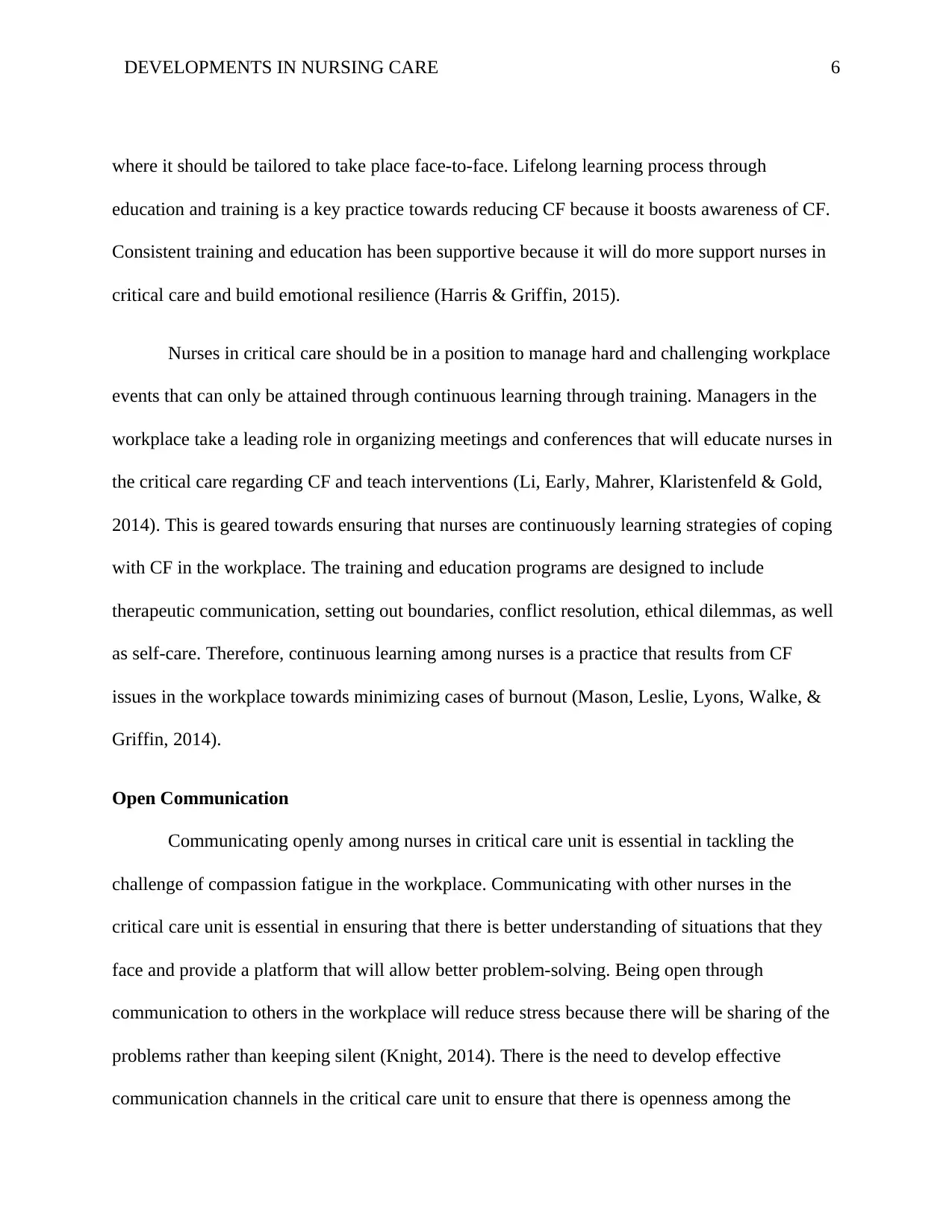
DEVELOPMENTS IN NURSING CARE 6
where it should be tailored to take place face-to-face. Lifelong learning process through
education and training is a key practice towards reducing CF because it boosts awareness of CF.
Consistent training and education has been supportive because it will do more support nurses in
critical care and build emotional resilience (Harris & Griffin, 2015).
Nurses in critical care should be in a position to manage hard and challenging workplace
events that can only be attained through continuous learning through training. Managers in the
workplace take a leading role in organizing meetings and conferences that will educate nurses in
the critical care regarding CF and teach interventions (Li, Early, Mahrer, Klaristenfeld & Gold,
2014). This is geared towards ensuring that nurses are continuously learning strategies of coping
with CF in the workplace. The training and education programs are designed to include
therapeutic communication, setting out boundaries, conflict resolution, ethical dilemmas, as well
as self-care. Therefore, continuous learning among nurses is a practice that results from CF
issues in the workplace towards minimizing cases of burnout (Mason, Leslie, Lyons, Walke, &
Griffin, 2014).
Open Communication
Communicating openly among nurses in critical care unit is essential in tackling the
challenge of compassion fatigue in the workplace. Communicating with other nurses in the
critical care unit is essential in ensuring that there is better understanding of situations that they
face and provide a platform that will allow better problem-solving. Being open through
communication to others in the workplace will reduce stress because there will be sharing of the
problems rather than keeping silent (Knight, 2014). There is the need to develop effective
communication channels in the critical care unit to ensure that there is openness among the
where it should be tailored to take place face-to-face. Lifelong learning process through
education and training is a key practice towards reducing CF because it boosts awareness of CF.
Consistent training and education has been supportive because it will do more support nurses in
critical care and build emotional resilience (Harris & Griffin, 2015).
Nurses in critical care should be in a position to manage hard and challenging workplace
events that can only be attained through continuous learning through training. Managers in the
workplace take a leading role in organizing meetings and conferences that will educate nurses in
the critical care regarding CF and teach interventions (Li, Early, Mahrer, Klaristenfeld & Gold,
2014). This is geared towards ensuring that nurses are continuously learning strategies of coping
with CF in the workplace. The training and education programs are designed to include
therapeutic communication, setting out boundaries, conflict resolution, ethical dilemmas, as well
as self-care. Therefore, continuous learning among nurses is a practice that results from CF
issues in the workplace towards minimizing cases of burnout (Mason, Leslie, Lyons, Walke, &
Griffin, 2014).
Open Communication
Communicating openly among nurses in critical care unit is essential in tackling the
challenge of compassion fatigue in the workplace. Communicating with other nurses in the
critical care unit is essential in ensuring that there is better understanding of situations that they
face and provide a platform that will allow better problem-solving. Being open through
communication to others in the workplace will reduce stress because there will be sharing of the
problems rather than keeping silent (Knight, 2014). There is the need to develop effective
communication channels in the critical care unit to ensure that there is openness among the
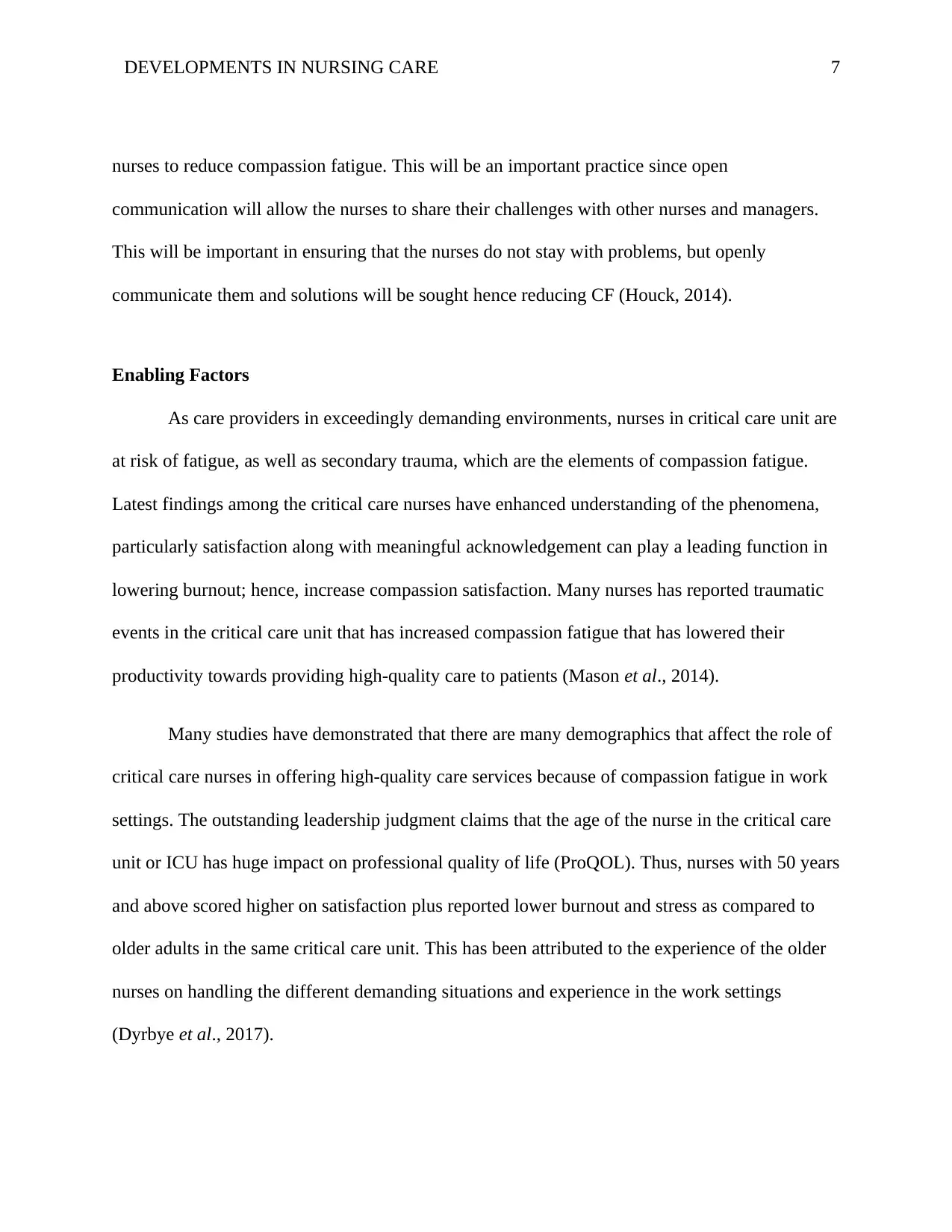
DEVELOPMENTS IN NURSING CARE 7
nurses to reduce compassion fatigue. This will be an important practice since open
communication will allow the nurses to share their challenges with other nurses and managers.
This will be important in ensuring that the nurses do not stay with problems, but openly
communicate them and solutions will be sought hence reducing CF (Houck, 2014).
Enabling Factors
As care providers in exceedingly demanding environments, nurses in critical care unit are
at risk of fatigue, as well as secondary trauma, which are the elements of compassion fatigue.
Latest findings among the critical care nurses have enhanced understanding of the phenomena,
particularly satisfaction along with meaningful acknowledgement can play a leading function in
lowering burnout; hence, increase compassion satisfaction. Many nurses has reported traumatic
events in the critical care unit that has increased compassion fatigue that has lowered their
productivity towards providing high-quality care to patients (Mason et al., 2014).
Many studies have demonstrated that there are many demographics that affect the role of
critical care nurses in offering high-quality care services because of compassion fatigue in work
settings. The outstanding leadership judgment claims that the age of the nurse in the critical care
unit or ICU has huge impact on professional quality of life (ProQOL). Thus, nurses with 50 years
and above scored higher on satisfaction plus reported lower burnout and stress as compared to
older adults in the same critical care unit. This has been attributed to the experience of the older
nurses on handling the different demanding situations and experience in the work settings
(Dyrbye et al., 2017).
nurses to reduce compassion fatigue. This will be an important practice since open
communication will allow the nurses to share their challenges with other nurses and managers.
This will be important in ensuring that the nurses do not stay with problems, but openly
communicate them and solutions will be sought hence reducing CF (Houck, 2014).
Enabling Factors
As care providers in exceedingly demanding environments, nurses in critical care unit are
at risk of fatigue, as well as secondary trauma, which are the elements of compassion fatigue.
Latest findings among the critical care nurses have enhanced understanding of the phenomena,
particularly satisfaction along with meaningful acknowledgement can play a leading function in
lowering burnout; hence, increase compassion satisfaction. Many nurses has reported traumatic
events in the critical care unit that has increased compassion fatigue that has lowered their
productivity towards providing high-quality care to patients (Mason et al., 2014).
Many studies have demonstrated that there are many demographics that affect the role of
critical care nurses in offering high-quality care services because of compassion fatigue in work
settings. The outstanding leadership judgment claims that the age of the nurse in the critical care
unit or ICU has huge impact on professional quality of life (ProQOL). Thus, nurses with 50 years
and above scored higher on satisfaction plus reported lower burnout and stress as compared to
older adults in the same critical care unit. This has been attributed to the experience of the older
nurses on handling the different demanding situations and experience in the work settings
(Dyrbye et al., 2017).
Paraphrase This Document
Need a fresh take? Get an instant paraphrase of this document with our AI Paraphraser
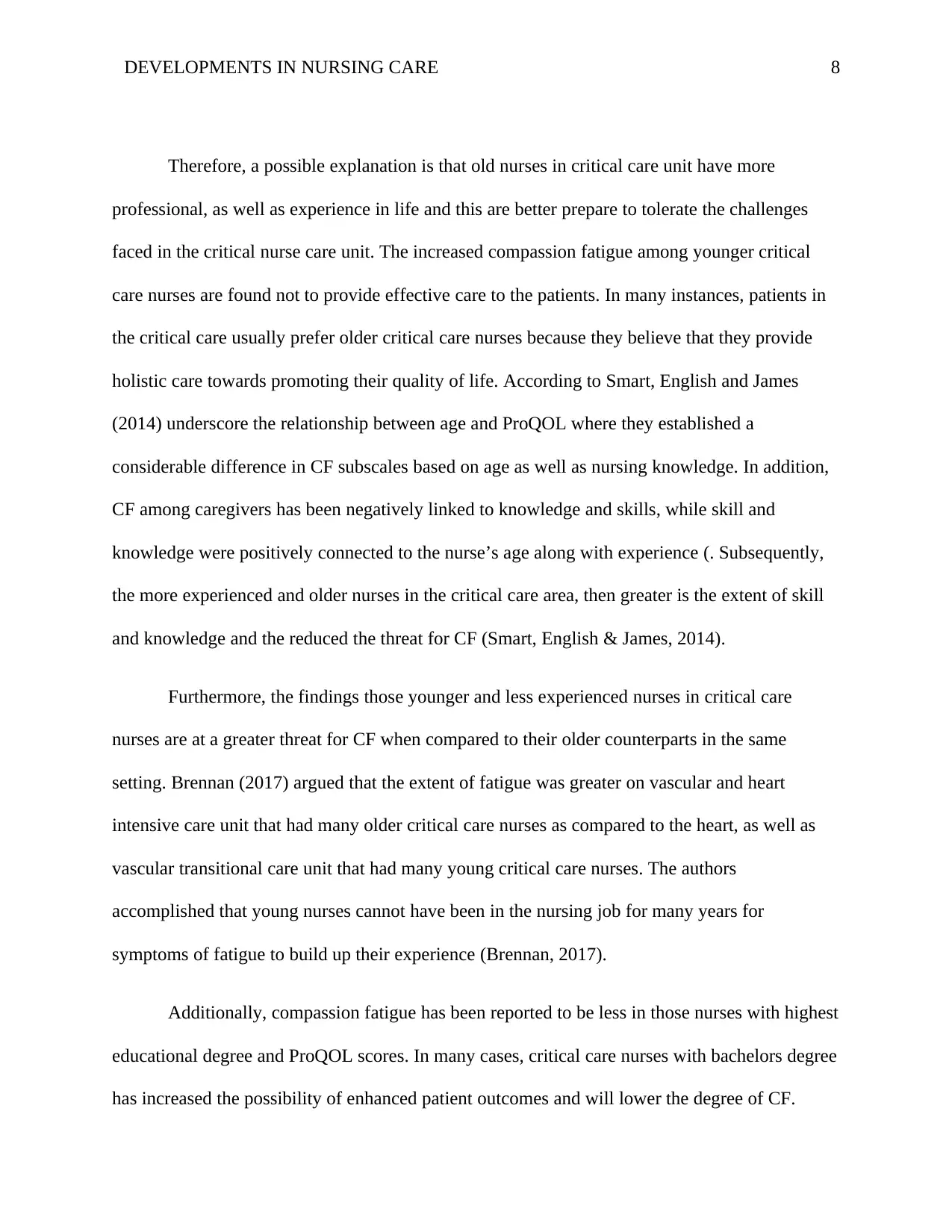
DEVELOPMENTS IN NURSING CARE 8
Therefore, a possible explanation is that old nurses in critical care unit have more
professional, as well as experience in life and this are better prepare to tolerate the challenges
faced in the critical nurse care unit. The increased compassion fatigue among younger critical
care nurses are found not to provide effective care to the patients. In many instances, patients in
the critical care usually prefer older critical care nurses because they believe that they provide
holistic care towards promoting their quality of life. According to Smart, English and James
(2014) underscore the relationship between age and ProQOL where they established a
considerable difference in CF subscales based on age as well as nursing knowledge. In addition,
CF among caregivers has been negatively linked to knowledge and skills, while skill and
knowledge were positively connected to the nurse’s age along with experience (. Subsequently,
the more experienced and older nurses in the critical care area, then greater is the extent of skill
and knowledge and the reduced the threat for CF (Smart, English & James, 2014).
Furthermore, the findings those younger and less experienced nurses in critical care
nurses are at a greater threat for CF when compared to their older counterparts in the same
setting. Brennan (2017) argued that the extent of fatigue was greater on vascular and heart
intensive care unit that had many older critical care nurses as compared to the heart, as well as
vascular transitional care unit that had many young critical care nurses. The authors
accomplished that young nurses cannot have been in the nursing job for many years for
symptoms of fatigue to build up their experience (Brennan, 2017).
Additionally, compassion fatigue has been reported to be less in those nurses with highest
educational degree and ProQOL scores. In many cases, critical care nurses with bachelors degree
has increased the possibility of enhanced patient outcomes and will lower the degree of CF.
Therefore, a possible explanation is that old nurses in critical care unit have more
professional, as well as experience in life and this are better prepare to tolerate the challenges
faced in the critical nurse care unit. The increased compassion fatigue among younger critical
care nurses are found not to provide effective care to the patients. In many instances, patients in
the critical care usually prefer older critical care nurses because they believe that they provide
holistic care towards promoting their quality of life. According to Smart, English and James
(2014) underscore the relationship between age and ProQOL where they established a
considerable difference in CF subscales based on age as well as nursing knowledge. In addition,
CF among caregivers has been negatively linked to knowledge and skills, while skill and
knowledge were positively connected to the nurse’s age along with experience (. Subsequently,
the more experienced and older nurses in the critical care area, then greater is the extent of skill
and knowledge and the reduced the threat for CF (Smart, English & James, 2014).
Furthermore, the findings those younger and less experienced nurses in critical care
nurses are at a greater threat for CF when compared to their older counterparts in the same
setting. Brennan (2017) argued that the extent of fatigue was greater on vascular and heart
intensive care unit that had many older critical care nurses as compared to the heart, as well as
vascular transitional care unit that had many young critical care nurses. The authors
accomplished that young nurses cannot have been in the nursing job for many years for
symptoms of fatigue to build up their experience (Brennan, 2017).
Additionally, compassion fatigue has been reported to be less in those nurses with highest
educational degree and ProQOL scores. In many cases, critical care nurses with bachelors degree
has increased the possibility of enhanced patient outcomes and will lower the degree of CF.
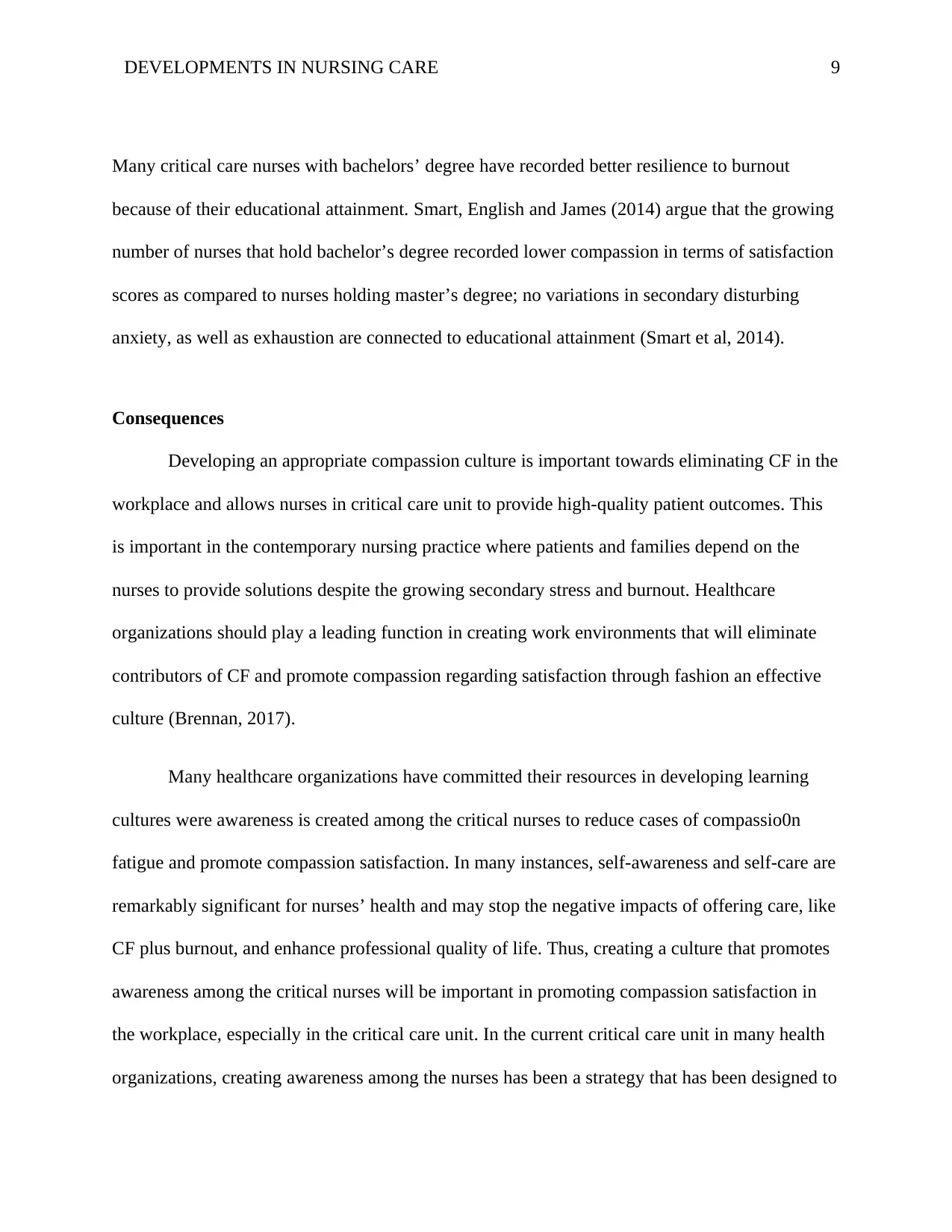
DEVELOPMENTS IN NURSING CARE 9
Many critical care nurses with bachelors’ degree have recorded better resilience to burnout
because of their educational attainment. Smart, English and James (2014) argue that the growing
number of nurses that hold bachelor’s degree recorded lower compassion in terms of satisfaction
scores as compared to nurses holding master’s degree; no variations in secondary disturbing
anxiety, as well as exhaustion are connected to educational attainment (Smart et al, 2014).
Consequences
Developing an appropriate compassion culture is important towards eliminating CF in the
workplace and allows nurses in critical care unit to provide high-quality patient outcomes. This
is important in the contemporary nursing practice where patients and families depend on the
nurses to provide solutions despite the growing secondary stress and burnout. Healthcare
organizations should play a leading function in creating work environments that will eliminate
contributors of CF and promote compassion regarding satisfaction through fashion an effective
culture (Brennan, 2017).
Many healthcare organizations have committed their resources in developing learning
cultures were awareness is created among the critical nurses to reduce cases of compassio0n
fatigue and promote compassion satisfaction. In many instances, self-awareness and self-care are
remarkably significant for nurses’ health and may stop the negative impacts of offering care, like
CF plus burnout, and enhance professional quality of life. Thus, creating a culture that promotes
awareness among the critical nurses will be important in promoting compassion satisfaction in
the workplace, especially in the critical care unit. In the current critical care unit in many health
organizations, creating awareness among the nurses has been a strategy that has been designed to
Many critical care nurses with bachelors’ degree have recorded better resilience to burnout
because of their educational attainment. Smart, English and James (2014) argue that the growing
number of nurses that hold bachelor’s degree recorded lower compassion in terms of satisfaction
scores as compared to nurses holding master’s degree; no variations in secondary disturbing
anxiety, as well as exhaustion are connected to educational attainment (Smart et al, 2014).
Consequences
Developing an appropriate compassion culture is important towards eliminating CF in the
workplace and allows nurses in critical care unit to provide high-quality patient outcomes. This
is important in the contemporary nursing practice where patients and families depend on the
nurses to provide solutions despite the growing secondary stress and burnout. Healthcare
organizations should play a leading function in creating work environments that will eliminate
contributors of CF and promote compassion regarding satisfaction through fashion an effective
culture (Brennan, 2017).
Many healthcare organizations have committed their resources in developing learning
cultures were awareness is created among the critical nurses to reduce cases of compassio0n
fatigue and promote compassion satisfaction. In many instances, self-awareness and self-care are
remarkably significant for nurses’ health and may stop the negative impacts of offering care, like
CF plus burnout, and enhance professional quality of life. Thus, creating a culture that promotes
awareness among the critical nurses will be important in promoting compassion satisfaction in
the workplace, especially in the critical care unit. In the current critical care unit in many health
organizations, creating awareness among the nurses has been a strategy that has been designed to
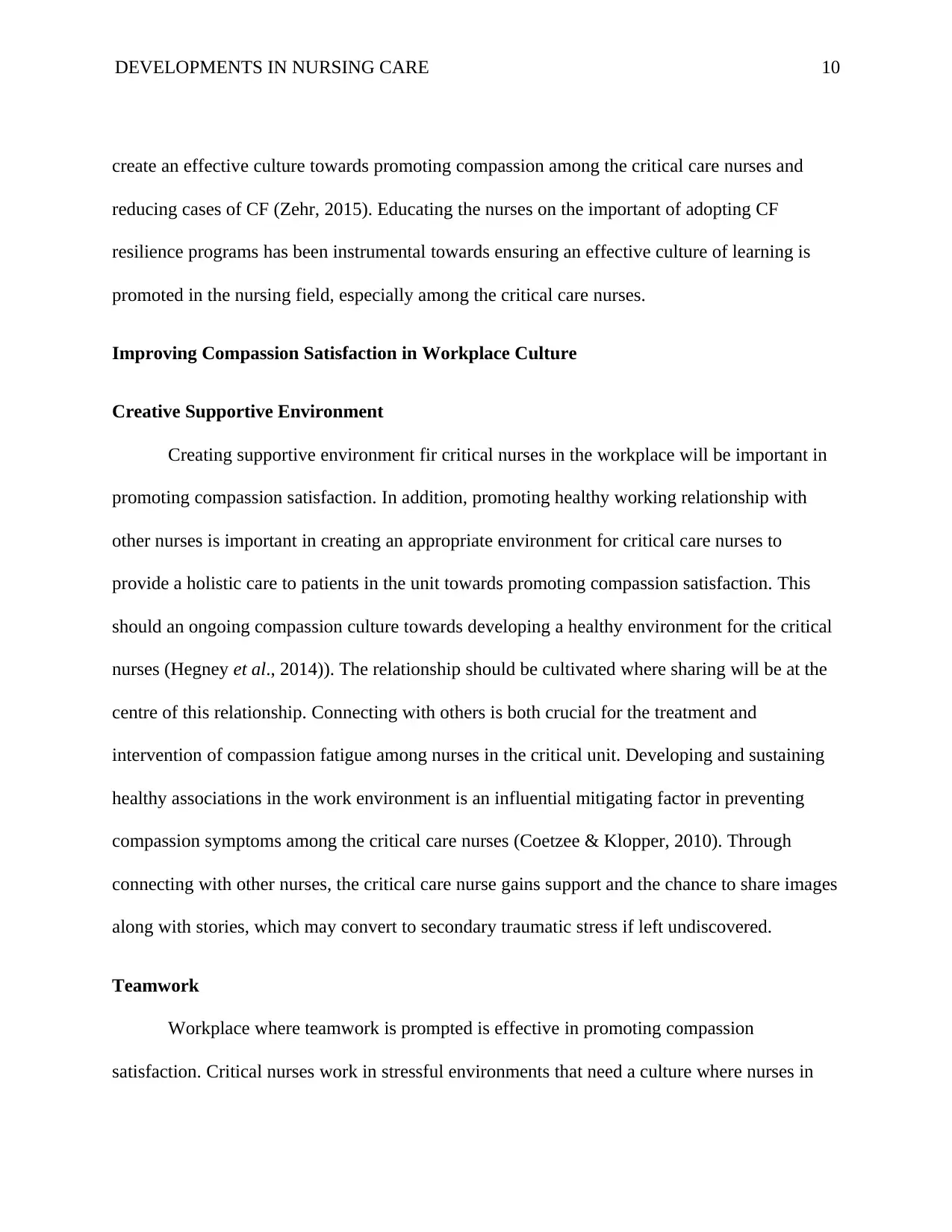
DEVELOPMENTS IN NURSING CARE 10
create an effective culture towards promoting compassion among the critical care nurses and
reducing cases of CF (Zehr, 2015). Educating the nurses on the important of adopting CF
resilience programs has been instrumental towards ensuring an effective culture of learning is
promoted in the nursing field, especially among the critical care nurses.
Improving Compassion Satisfaction in Workplace Culture
Creative Supportive Environment
Creating supportive environment fir critical nurses in the workplace will be important in
promoting compassion satisfaction. In addition, promoting healthy working relationship with
other nurses is important in creating an appropriate environment for critical care nurses to
provide a holistic care to patients in the unit towards promoting compassion satisfaction. This
should an ongoing compassion culture towards developing a healthy environment for the critical
nurses (Hegney et al., 2014)). The relationship should be cultivated where sharing will be at the
centre of this relationship. Connecting with others is both crucial for the treatment and
intervention of compassion fatigue among nurses in the critical unit. Developing and sustaining
healthy associations in the work environment is an influential mitigating factor in preventing
compassion symptoms among the critical care nurses (Coetzee & Klopper, 2010). Through
connecting with other nurses, the critical care nurse gains support and the chance to share images
along with stories, which may convert to secondary traumatic stress if left undiscovered.
Teamwork
Workplace where teamwork is prompted is effective in promoting compassion
satisfaction. Critical nurses work in stressful environments that need a culture where nurses in
create an effective culture towards promoting compassion among the critical care nurses and
reducing cases of CF (Zehr, 2015). Educating the nurses on the important of adopting CF
resilience programs has been instrumental towards ensuring an effective culture of learning is
promoted in the nursing field, especially among the critical care nurses.
Improving Compassion Satisfaction in Workplace Culture
Creative Supportive Environment
Creating supportive environment fir critical nurses in the workplace will be important in
promoting compassion satisfaction. In addition, promoting healthy working relationship with
other nurses is important in creating an appropriate environment for critical care nurses to
provide a holistic care to patients in the unit towards promoting compassion satisfaction. This
should an ongoing compassion culture towards developing a healthy environment for the critical
nurses (Hegney et al., 2014)). The relationship should be cultivated where sharing will be at the
centre of this relationship. Connecting with others is both crucial for the treatment and
intervention of compassion fatigue among nurses in the critical unit. Developing and sustaining
healthy associations in the work environment is an influential mitigating factor in preventing
compassion symptoms among the critical care nurses (Coetzee & Klopper, 2010). Through
connecting with other nurses, the critical care nurse gains support and the chance to share images
along with stories, which may convert to secondary traumatic stress if left undiscovered.
Teamwork
Workplace where teamwork is prompted is effective in promoting compassion
satisfaction. Critical nurses work in stressful environments that need a culture where nurses in
Secure Best Marks with AI Grader
Need help grading? Try our AI Grader for instant feedback on your assignments.
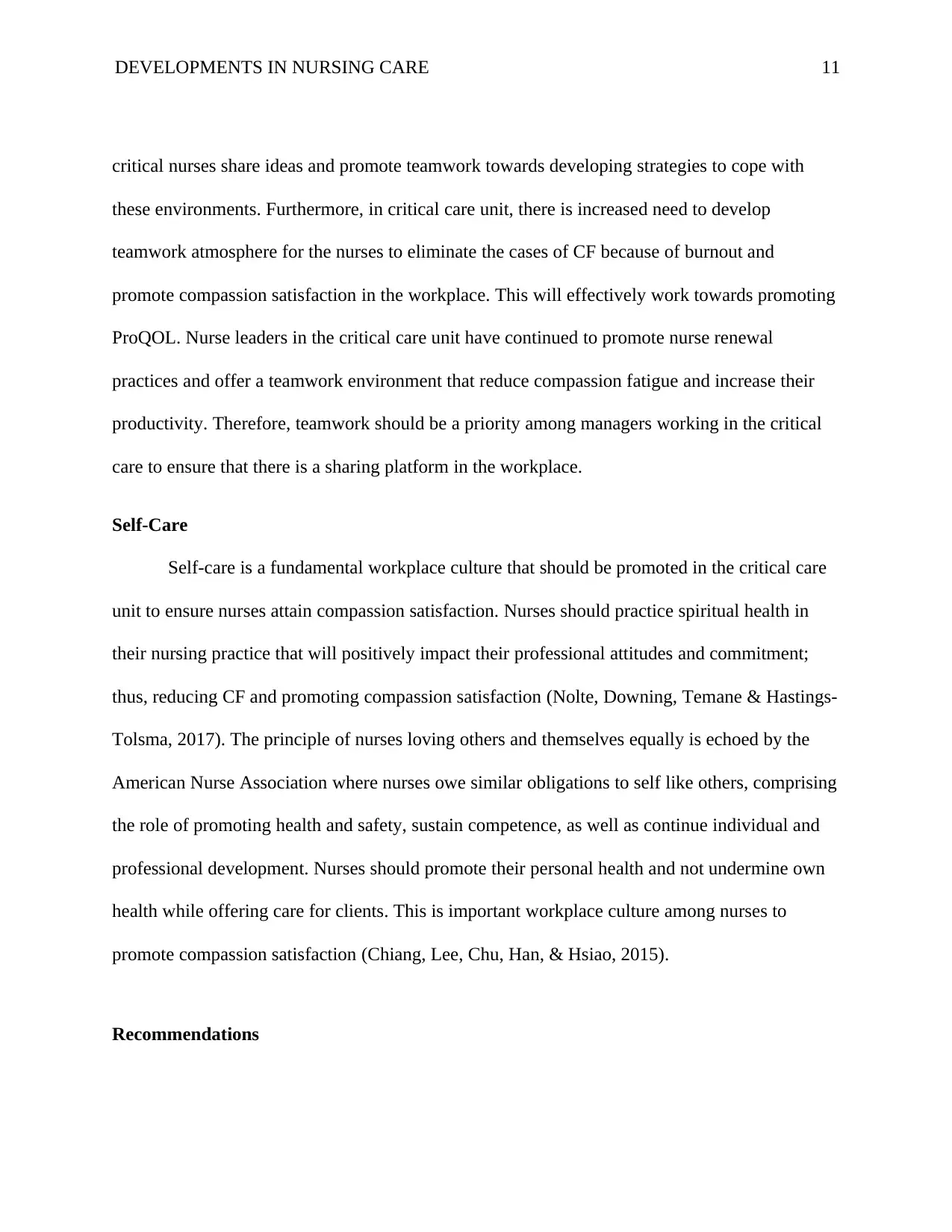
DEVELOPMENTS IN NURSING CARE 11
critical nurses share ideas and promote teamwork towards developing strategies to cope with
these environments. Furthermore, in critical care unit, there is increased need to develop
teamwork atmosphere for the nurses to eliminate the cases of CF because of burnout and
promote compassion satisfaction in the workplace. This will effectively work towards promoting
ProQOL. Nurse leaders in the critical care unit have continued to promote nurse renewal
practices and offer a teamwork environment that reduce compassion fatigue and increase their
productivity. Therefore, teamwork should be a priority among managers working in the critical
care to ensure that there is a sharing platform in the workplace.
Self-Care
Self-care is a fundamental workplace culture that should be promoted in the critical care
unit to ensure nurses attain compassion satisfaction. Nurses should practice spiritual health in
their nursing practice that will positively impact their professional attitudes and commitment;
thus, reducing CF and promoting compassion satisfaction (Nolte, Downing, Temane & Hastings-
Tolsma, 2017). The principle of nurses loving others and themselves equally is echoed by the
American Nurse Association where nurses owe similar obligations to self like others, comprising
the role of promoting health and safety, sustain competence, as well as continue individual and
professional development. Nurses should promote their personal health and not undermine own
health while offering care for clients. This is important workplace culture among nurses to
promote compassion satisfaction (Chiang, Lee, Chu, Han, & Hsiao, 2015).
Recommendations
critical nurses share ideas and promote teamwork towards developing strategies to cope with
these environments. Furthermore, in critical care unit, there is increased need to develop
teamwork atmosphere for the nurses to eliminate the cases of CF because of burnout and
promote compassion satisfaction in the workplace. This will effectively work towards promoting
ProQOL. Nurse leaders in the critical care unit have continued to promote nurse renewal
practices and offer a teamwork environment that reduce compassion fatigue and increase their
productivity. Therefore, teamwork should be a priority among managers working in the critical
care to ensure that there is a sharing platform in the workplace.
Self-Care
Self-care is a fundamental workplace culture that should be promoted in the critical care
unit to ensure nurses attain compassion satisfaction. Nurses should practice spiritual health in
their nursing practice that will positively impact their professional attitudes and commitment;
thus, reducing CF and promoting compassion satisfaction (Nolte, Downing, Temane & Hastings-
Tolsma, 2017). The principle of nurses loving others and themselves equally is echoed by the
American Nurse Association where nurses owe similar obligations to self like others, comprising
the role of promoting health and safety, sustain competence, as well as continue individual and
professional development. Nurses should promote their personal health and not undermine own
health while offering care for clients. This is important workplace culture among nurses to
promote compassion satisfaction (Chiang, Lee, Chu, Han, & Hsiao, 2015).
Recommendations
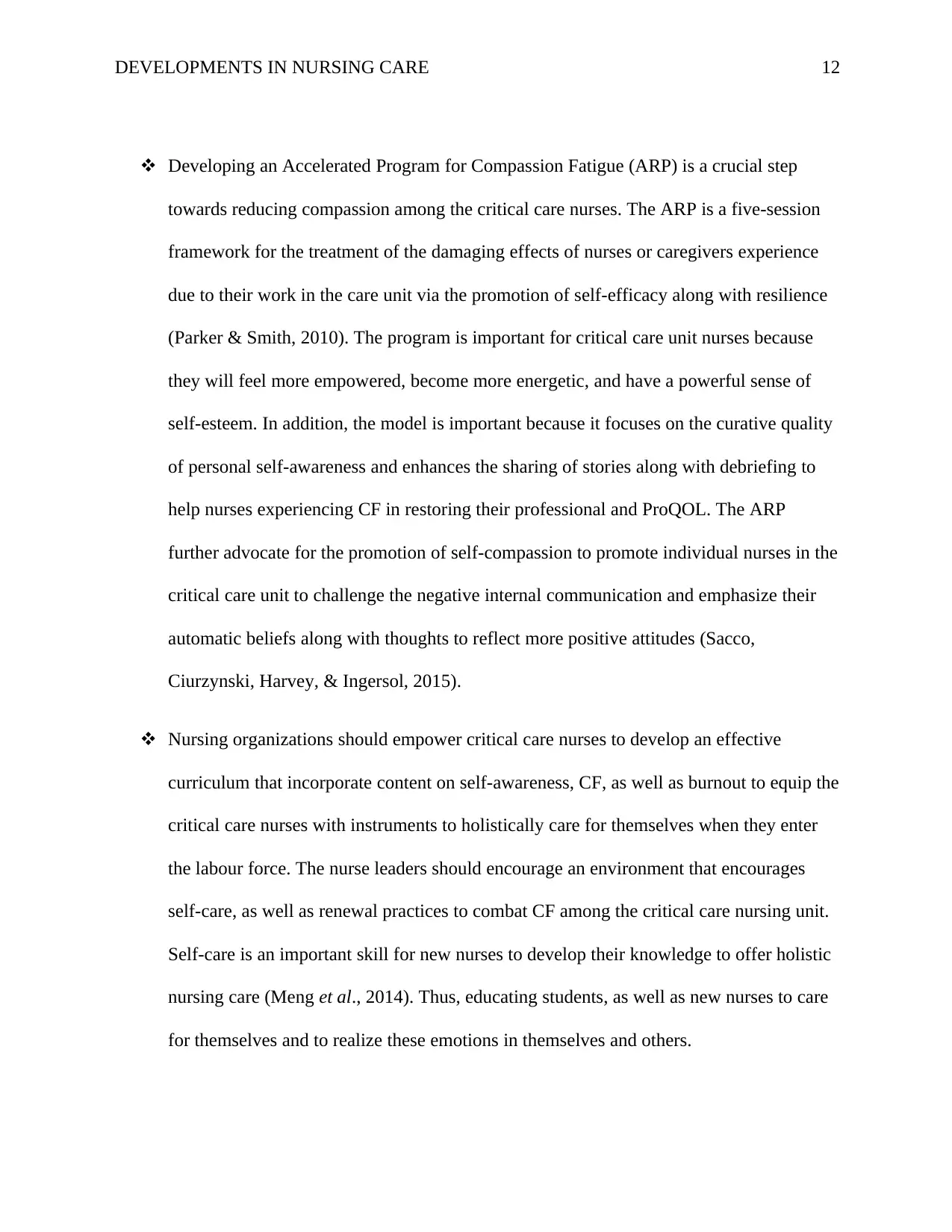
DEVELOPMENTS IN NURSING CARE 12
Developing an Accelerated Program for Compassion Fatigue (ARP) is a crucial step
towards reducing compassion among the critical care nurses. The ARP is a five-session
framework for the treatment of the damaging effects of nurses or caregivers experience
due to their work in the care unit via the promotion of self-efficacy along with resilience
(Parker & Smith, 2010). The program is important for critical care unit nurses because
they will feel more empowered, become more energetic, and have a powerful sense of
self-esteem. In addition, the model is important because it focuses on the curative quality
of personal self-awareness and enhances the sharing of stories along with debriefing to
help nurses experiencing CF in restoring their professional and ProQOL. The ARP
further advocate for the promotion of self-compassion to promote individual nurses in the
critical care unit to challenge the negative internal communication and emphasize their
automatic beliefs along with thoughts to reflect more positive attitudes (Sacco,
Ciurzynski, Harvey, & Ingersol, 2015).
Nursing organizations should empower critical care nurses to develop an effective
curriculum that incorporate content on self-awareness, CF, as well as burnout to equip the
critical care nurses with instruments to holistically care for themselves when they enter
the labour force. The nurse leaders should encourage an environment that encourages
self-care, as well as renewal practices to combat CF among the critical care nursing unit.
Self-care is an important skill for new nurses to develop their knowledge to offer holistic
nursing care (Meng et al., 2014). Thus, educating students, as well as new nurses to care
for themselves and to realize these emotions in themselves and others.
Developing an Accelerated Program for Compassion Fatigue (ARP) is a crucial step
towards reducing compassion among the critical care nurses. The ARP is a five-session
framework for the treatment of the damaging effects of nurses or caregivers experience
due to their work in the care unit via the promotion of self-efficacy along with resilience
(Parker & Smith, 2010). The program is important for critical care unit nurses because
they will feel more empowered, become more energetic, and have a powerful sense of
self-esteem. In addition, the model is important because it focuses on the curative quality
of personal self-awareness and enhances the sharing of stories along with debriefing to
help nurses experiencing CF in restoring their professional and ProQOL. The ARP
further advocate for the promotion of self-compassion to promote individual nurses in the
critical care unit to challenge the negative internal communication and emphasize their
automatic beliefs along with thoughts to reflect more positive attitudes (Sacco,
Ciurzynski, Harvey, & Ingersol, 2015).
Nursing organizations should empower critical care nurses to develop an effective
curriculum that incorporate content on self-awareness, CF, as well as burnout to equip the
critical care nurses with instruments to holistically care for themselves when they enter
the labour force. The nurse leaders should encourage an environment that encourages
self-care, as well as renewal practices to combat CF among the critical care nursing unit.
Self-care is an important skill for new nurses to develop their knowledge to offer holistic
nursing care (Meng et al., 2014). Thus, educating students, as well as new nurses to care
for themselves and to realize these emotions in themselves and others.
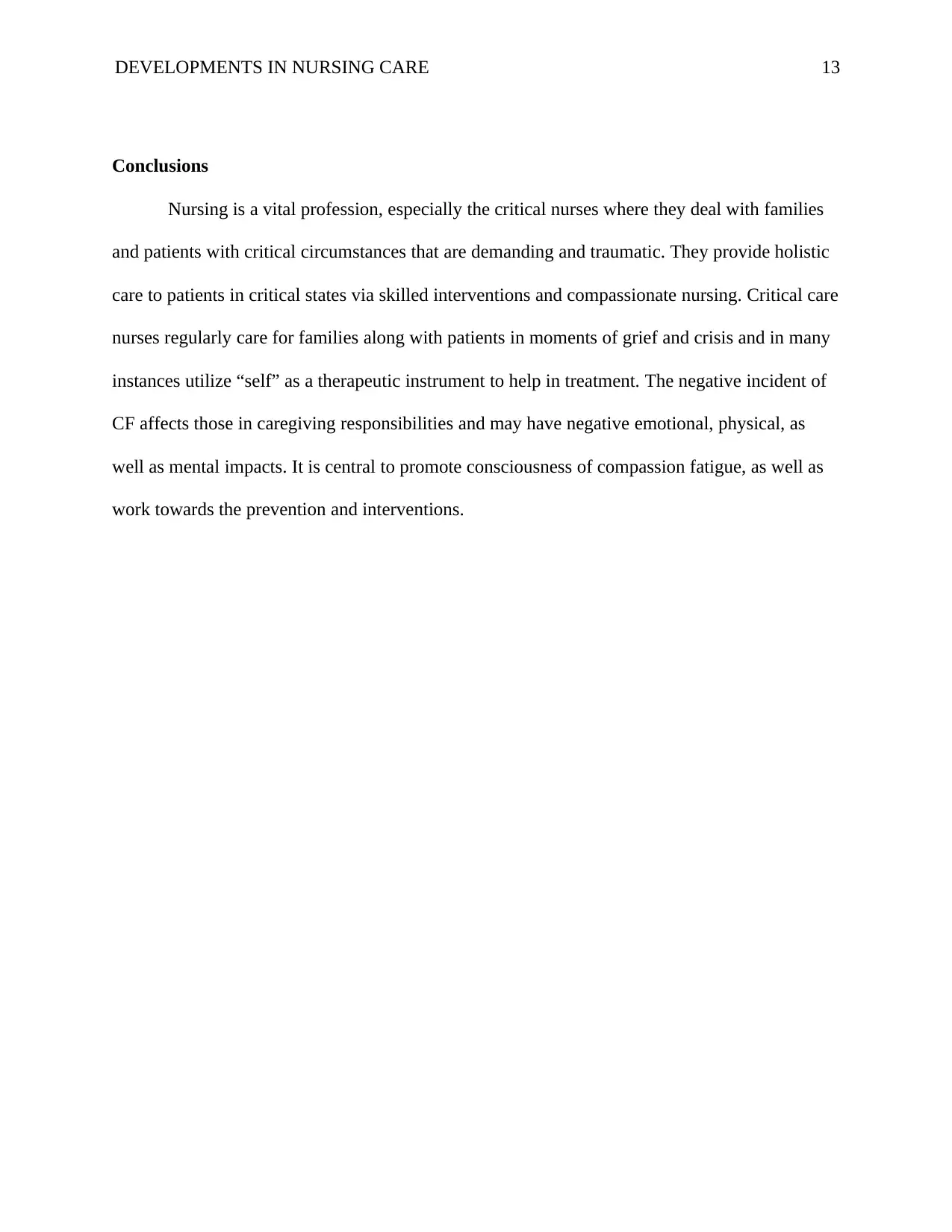
DEVELOPMENTS IN NURSING CARE 13
Conclusions
Nursing is a vital profession, especially the critical nurses where they deal with families
and patients with critical circumstances that are demanding and traumatic. They provide holistic
care to patients in critical states via skilled interventions and compassionate nursing. Critical care
nurses regularly care for families along with patients in moments of grief and crisis and in many
instances utilize “self” as a therapeutic instrument to help in treatment. The negative incident of
CF affects those in caregiving responsibilities and may have negative emotional, physical, as
well as mental impacts. It is central to promote consciousness of compassion fatigue, as well as
work towards the prevention and interventions.
Conclusions
Nursing is a vital profession, especially the critical nurses where they deal with families
and patients with critical circumstances that are demanding and traumatic. They provide holistic
care to patients in critical states via skilled interventions and compassionate nursing. Critical care
nurses regularly care for families along with patients in moments of grief and crisis and in many
instances utilize “self” as a therapeutic instrument to help in treatment. The negative incident of
CF affects those in caregiving responsibilities and may have negative emotional, physical, as
well as mental impacts. It is central to promote consciousness of compassion fatigue, as well as
work towards the prevention and interventions.
Paraphrase This Document
Need a fresh take? Get an instant paraphrase of this document with our AI Paraphraser
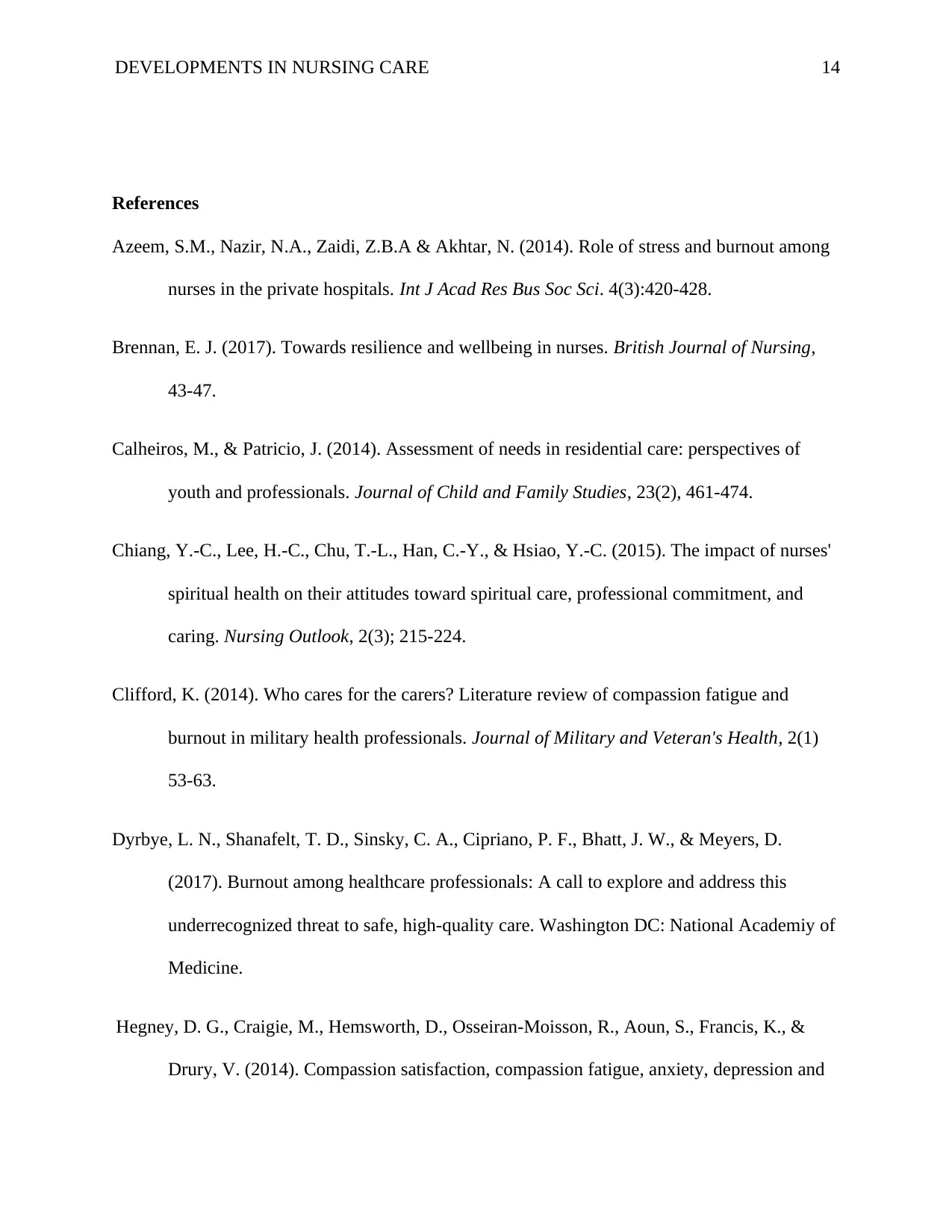
DEVELOPMENTS IN NURSING CARE 14
References
Azeem, S.M., Nazir, N.A., Zaidi, Z.B.A & Akhtar, N. (2014). Role of stress and burnout among
nurses in the private hospitals. Int J Acad Res Bus Soc Sci. 4(3):420-428.
Brennan, E. J. (2017). Towards resilience and wellbeing in nurses. British Journal of Nursing,
43-47.
Calheiros, M., & Patricio, J. (2014). Assessment of needs in residential care: perspectives of
youth and professionals. Journal of Child and Family Studies, 23(2), 461-474.
Chiang, Y.-C., Lee, H.-C., Chu, T.-L., Han, C.-Y., & Hsiao, Y.-C. (2015). The impact of nurses'
spiritual health on their attitudes toward spiritual care, professional commitment, and
caring. Nursing Outlook, 2(3); 215-224.
Clifford, K. (2014). Who cares for the carers? Literature review of compassion fatigue and
burnout in military health professionals. Journal of Military and Veteran's Health, 2(1)
53-63.
Dyrbye, L. N., Shanafelt, T. D., Sinsky, C. A., Cipriano, P. F., Bhatt, J. W., & Meyers, D.
(2017). Burnout among healthcare professionals: A call to explore and address this
underrecognized threat to safe, high-quality care. Washington DC: National Academiy of
Medicine.
Hegney, D. G., Craigie, M., Hemsworth, D., Osseiran-Moisson, R., Aoun, S., Francis, K., &
Drury, V. (2014). Compassion satisfaction, compassion fatigue, anxiety, depression and
References
Azeem, S.M., Nazir, N.A., Zaidi, Z.B.A & Akhtar, N. (2014). Role of stress and burnout among
nurses in the private hospitals. Int J Acad Res Bus Soc Sci. 4(3):420-428.
Brennan, E. J. (2017). Towards resilience and wellbeing in nurses. British Journal of Nursing,
43-47.
Calheiros, M., & Patricio, J. (2014). Assessment of needs in residential care: perspectives of
youth and professionals. Journal of Child and Family Studies, 23(2), 461-474.
Chiang, Y.-C., Lee, H.-C., Chu, T.-L., Han, C.-Y., & Hsiao, Y.-C. (2015). The impact of nurses'
spiritual health on their attitudes toward spiritual care, professional commitment, and
caring. Nursing Outlook, 2(3); 215-224.
Clifford, K. (2014). Who cares for the carers? Literature review of compassion fatigue and
burnout in military health professionals. Journal of Military and Veteran's Health, 2(1)
53-63.
Dyrbye, L. N., Shanafelt, T. D., Sinsky, C. A., Cipriano, P. F., Bhatt, J. W., & Meyers, D.
(2017). Burnout among healthcare professionals: A call to explore and address this
underrecognized threat to safe, high-quality care. Washington DC: National Academiy of
Medicine.
Hegney, D. G., Craigie, M., Hemsworth, D., Osseiran-Moisson, R., Aoun, S., Francis, K., &
Drury, V. (2014). Compassion satisfaction, compassion fatigue, anxiety, depression and
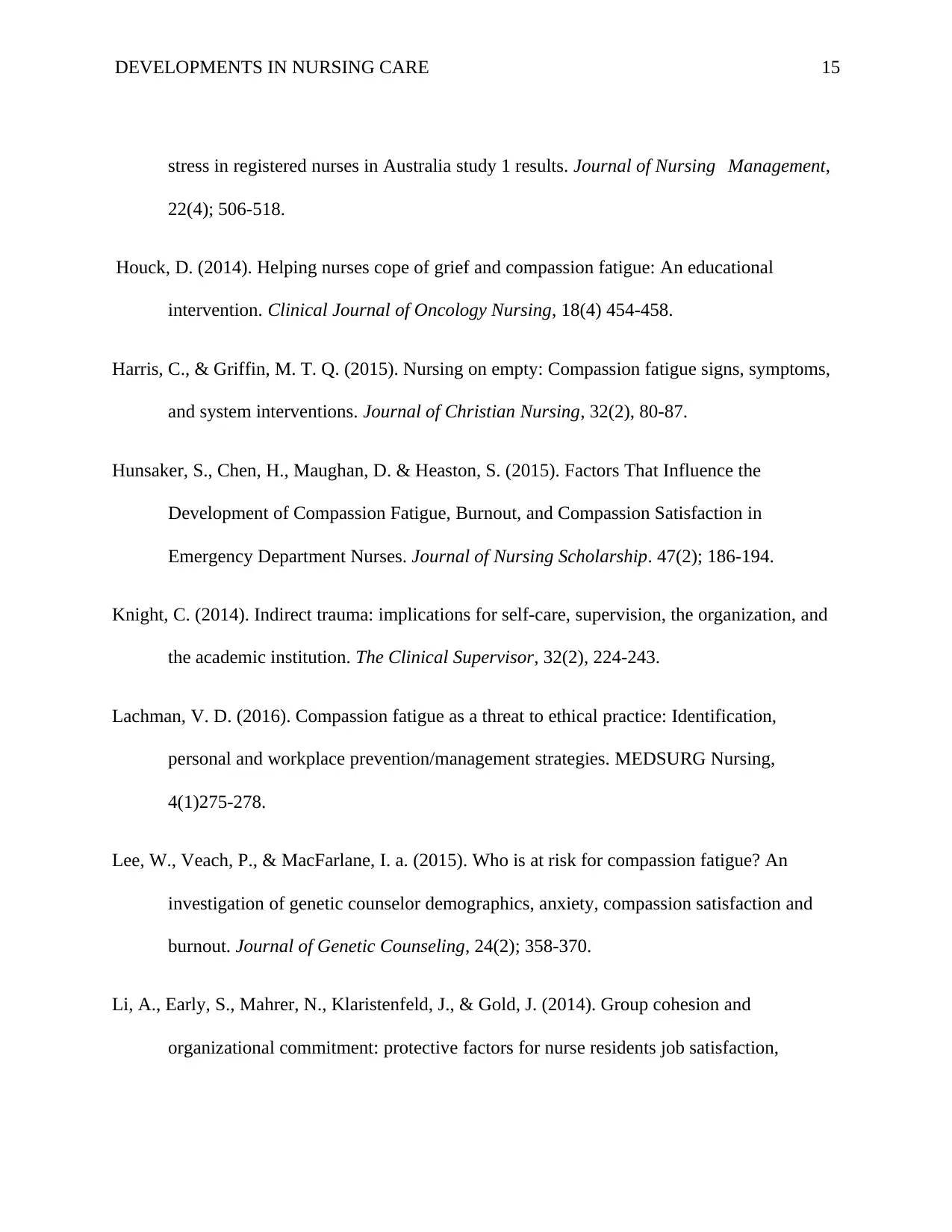
DEVELOPMENTS IN NURSING CARE 15
stress in registered nurses in Australia study 1 results. Journal of Nursing Management,
22(4); 506-518.
Houck, D. (2014). Helping nurses cope of grief and compassion fatigue: An educational
intervention. Clinical Journal of Oncology Nursing, 18(4) 454-458.
Harris, C., & Griffin, M. T. Q. (2015). Nursing on empty: Compassion fatigue signs, symptoms,
and system interventions. Journal of Christian Nursing, 32(2), 80-87.
Hunsaker, S., Chen, H., Maughan, D. & Heaston, S. (2015). Factors That Influence the
Development of Compassion Fatigue, Burnout, and Compassion Satisfaction in
Emergency Department Nurses. Journal of Nursing Scholarship. 47(2); 186-194.
Knight, C. (2014). Indirect trauma: implications for self-care, supervision, the organization, and
the academic institution. The Clinical Supervisor, 32(2), 224-243.
Lachman, V. D. (2016). Compassion fatigue as a threat to ethical practice: Identification,
personal and workplace prevention/management strategies. MEDSURG Nursing,
4(1)275-278.
Lee, W., Veach, P., & MacFarlane, I. a. (2015). Who is at risk for compassion fatigue? An
investigation of genetic counselor demographics, anxiety, compassion satisfaction and
burnout. Journal of Genetic Counseling, 24(2); 358-370.
Li, A., Early, S., Mahrer, N., Klaristenfeld, J., & Gold, J. (2014). Group cohesion and
organizational commitment: protective factors for nurse residents job satisfaction,
stress in registered nurses in Australia study 1 results. Journal of Nursing Management,
22(4); 506-518.
Houck, D. (2014). Helping nurses cope of grief and compassion fatigue: An educational
intervention. Clinical Journal of Oncology Nursing, 18(4) 454-458.
Harris, C., & Griffin, M. T. Q. (2015). Nursing on empty: Compassion fatigue signs, symptoms,
and system interventions. Journal of Christian Nursing, 32(2), 80-87.
Hunsaker, S., Chen, H., Maughan, D. & Heaston, S. (2015). Factors That Influence the
Development of Compassion Fatigue, Burnout, and Compassion Satisfaction in
Emergency Department Nurses. Journal of Nursing Scholarship. 47(2); 186-194.
Knight, C. (2014). Indirect trauma: implications for self-care, supervision, the organization, and
the academic institution. The Clinical Supervisor, 32(2), 224-243.
Lachman, V. D. (2016). Compassion fatigue as a threat to ethical practice: Identification,
personal and workplace prevention/management strategies. MEDSURG Nursing,
4(1)275-278.
Lee, W., Veach, P., & MacFarlane, I. a. (2015). Who is at risk for compassion fatigue? An
investigation of genetic counselor demographics, anxiety, compassion satisfaction and
burnout. Journal of Genetic Counseling, 24(2); 358-370.
Li, A., Early, S., Mahrer, N., Klaristenfeld, J., & Gold, J. (2014). Group cohesion and
organizational commitment: protective factors for nurse residents job satisfaction,
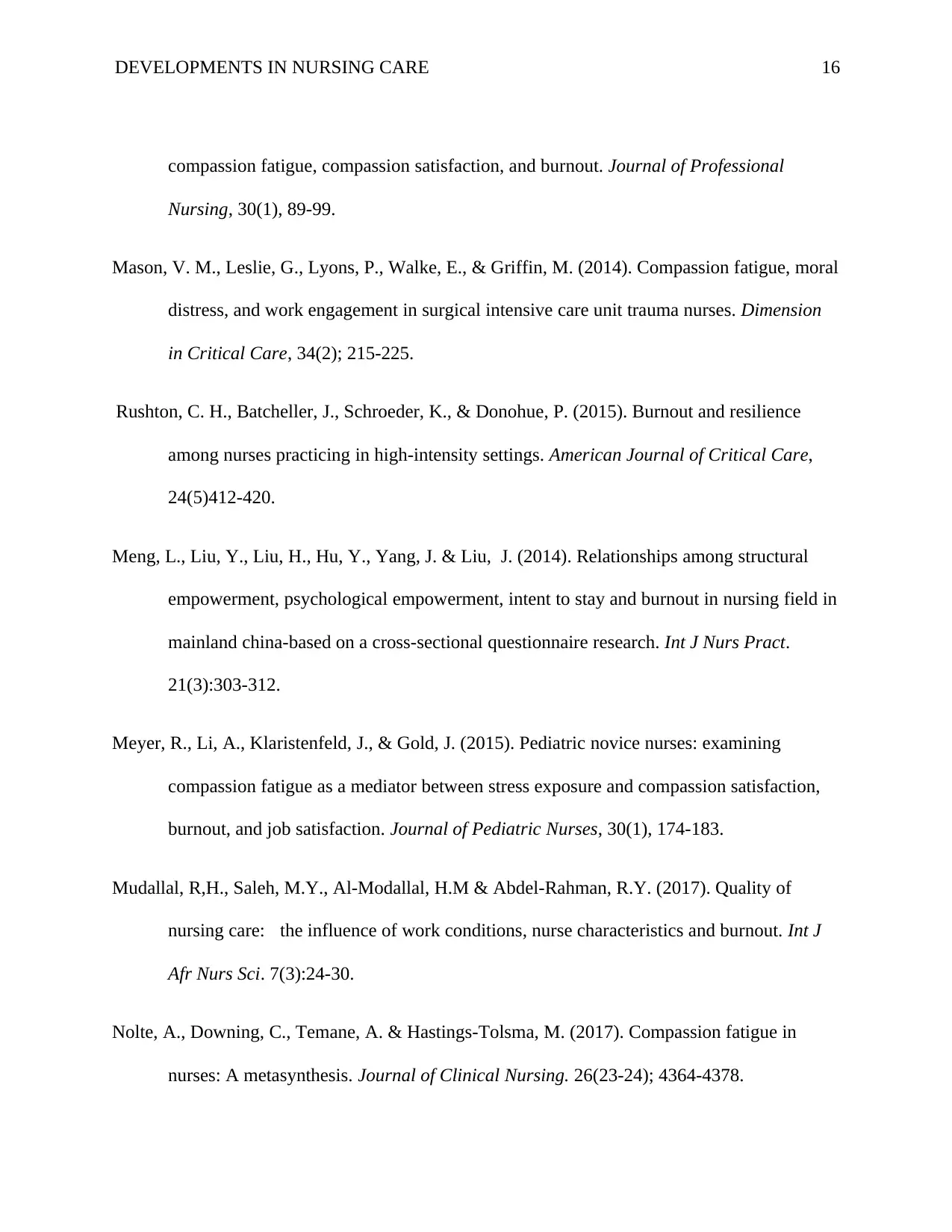
DEVELOPMENTS IN NURSING CARE 16
compassion fatigue, compassion satisfaction, and burnout. Journal of Professional
Nursing, 30(1), 89-99.
Mason, V. M., Leslie, G., Lyons, P., Walke, E., & Griffin, M. (2014). Compassion fatigue, moral
distress, and work engagement in surgical intensive care unit trauma nurses. Dimension
in Critical Care, 34(2); 215-225.
Rushton, C. H., Batcheller, J., Schroeder, K., & Donohue, P. (2015). Burnout and resilience
among nurses practicing in high-intensity settings. American Journal of Critical Care,
24(5)412-420.
Meng, L., Liu, Y., Liu, H., Hu, Y., Yang, J. & Liu, J. (2014). Relationships among structural
empowerment, psychological empowerment, intent to stay and burnout in nursing field in
mainland china-based on a cross-sectional questionnaire research. Int J Nurs Pract.
21(3):303-312.
Meyer, R., Li, A., Klaristenfeld, J., & Gold, J. (2015). Pediatric novice nurses: examining
compassion fatigue as a mediator between stress exposure and compassion satisfaction,
burnout, and job satisfaction. Journal of Pediatric Nurses, 30(1), 174-183.
Mudallal, R,H., Saleh, M.Y., Al-Modallal, H.M & Abdel-Rahman, R.Y. (2017). Quality of
nursing care: the influence of work conditions, nurse characteristics and burnout. Int J
Afr Nurs Sci. 7(3):24-30.
Nolte, A., Downing, C., Temane, A. & Hastings-Tolsma, M. (2017). Compassion fatigue in
nurses: A metasynthesis. Journal of Clinical Nursing. 26(23-24); 4364-4378.
compassion fatigue, compassion satisfaction, and burnout. Journal of Professional
Nursing, 30(1), 89-99.
Mason, V. M., Leslie, G., Lyons, P., Walke, E., & Griffin, M. (2014). Compassion fatigue, moral
distress, and work engagement in surgical intensive care unit trauma nurses. Dimension
in Critical Care, 34(2); 215-225.
Rushton, C. H., Batcheller, J., Schroeder, K., & Donohue, P. (2015). Burnout and resilience
among nurses practicing in high-intensity settings. American Journal of Critical Care,
24(5)412-420.
Meng, L., Liu, Y., Liu, H., Hu, Y., Yang, J. & Liu, J. (2014). Relationships among structural
empowerment, psychological empowerment, intent to stay and burnout in nursing field in
mainland china-based on a cross-sectional questionnaire research. Int J Nurs Pract.
21(3):303-312.
Meyer, R., Li, A., Klaristenfeld, J., & Gold, J. (2015). Pediatric novice nurses: examining
compassion fatigue as a mediator between stress exposure and compassion satisfaction,
burnout, and job satisfaction. Journal of Pediatric Nurses, 30(1), 174-183.
Mudallal, R,H., Saleh, M.Y., Al-Modallal, H.M & Abdel-Rahman, R.Y. (2017). Quality of
nursing care: the influence of work conditions, nurse characteristics and burnout. Int J
Afr Nurs Sci. 7(3):24-30.
Nolte, A., Downing, C., Temane, A. & Hastings-Tolsma, M. (2017). Compassion fatigue in
nurses: A metasynthesis. Journal of Clinical Nursing. 26(23-24); 4364-4378.
Secure Best Marks with AI Grader
Need help grading? Try our AI Grader for instant feedback on your assignments.
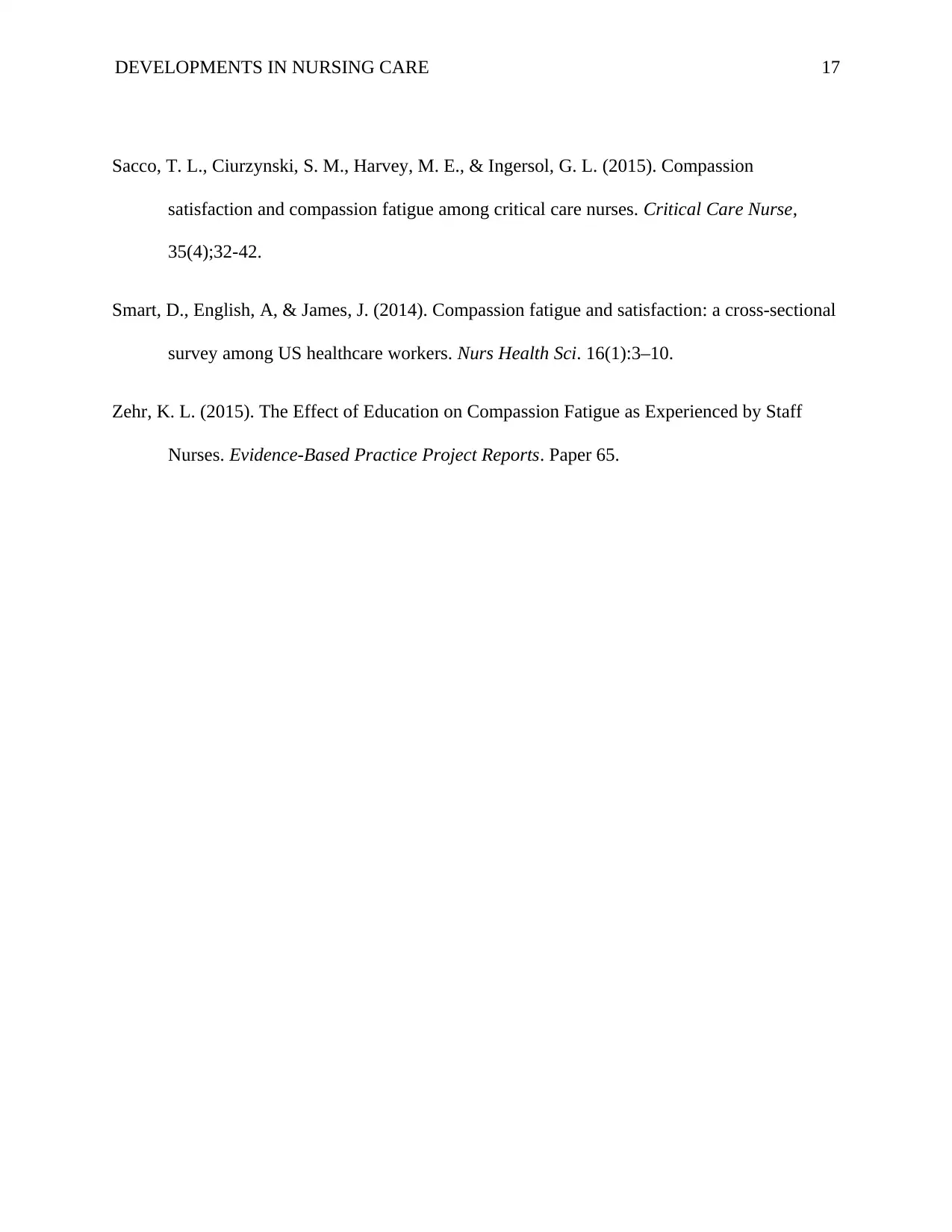
DEVELOPMENTS IN NURSING CARE 17
Sacco, T. L., Ciurzynski, S. M., Harvey, M. E., & Ingersol, G. L. (2015). Compassion
satisfaction and compassion fatigue among critical care nurses. Critical Care Nurse,
35(4);32-42.
Smart, D., English, A, & James, J. (2014). Compassion fatigue and satisfaction: a cross-sectional
survey among US healthcare workers. Nurs Health Sci. 16(1):3–10.
Zehr, K. L. (2015). The Effect of Education on Compassion Fatigue as Experienced by Staff
Nurses. Evidence-Based Practice Project Reports. Paper 65.
Sacco, T. L., Ciurzynski, S. M., Harvey, M. E., & Ingersol, G. L. (2015). Compassion
satisfaction and compassion fatigue among critical care nurses. Critical Care Nurse,
35(4);32-42.
Smart, D., English, A, & James, J. (2014). Compassion fatigue and satisfaction: a cross-sectional
survey among US healthcare workers. Nurs Health Sci. 16(1):3–10.
Zehr, K. L. (2015). The Effect of Education on Compassion Fatigue as Experienced by Staff
Nurses. Evidence-Based Practice Project Reports. Paper 65.
1 out of 17
Related Documents
Your All-in-One AI-Powered Toolkit for Academic Success.
+13062052269
info@desklib.com
Available 24*7 on WhatsApp / Email
![[object Object]](/_next/static/media/star-bottom.7253800d.svg)
Unlock your academic potential
© 2024 | Zucol Services PVT LTD | All rights reserved.





